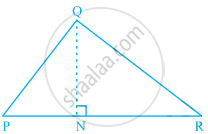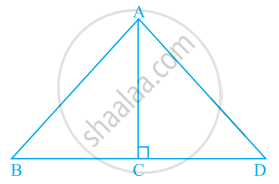Advertisements
Advertisements
प्रश्न
In a triangle ABC, if `|(1, 1, 1),(1 + sin"A", 1 + sin"B", 1 + sin"C"),(sin"A" + sin^2"A", sin"B" + sin^2"B", sin"C" + sin^2"C")|` = 0, then prove that ∆ABC is an isoceles triangle.
उत्तर
Let ∆ = `|(1, 1, 1),(1 + sin"A", 1 + sin"B", 1 + sin"C"),(sin"A" + sin^2"A", sin"B" + sin^2"B", sin"C" + sin^2"C")|`
= `|(1, 1, 1),(1 + sin"A", 1 + sin"B", 1 + sin"C"),(-cos^2"A", -cos^2"B", -cos^2"C")|` R3 → R3 – R2
= `|(1, 0, 0),(1 + sin"A", sin"B" - sin"A", sin"C" - sin"B"),(-cos^2"A", cos^2"A" - cos^2"B", cos^2"B" - cos^2"C")|` .......(C3 → C3 – C2 and C2 → C2 – C1)
Expanding along R1, we get
∆ = (sinB – sinA)(sin2C – sin2B) – (sinC – sin B)(sin2B – sin2A)
= (sinB – sinA)(sinC – sinB)(sinC – sin A)
= 0
⇒ Either sinB – sinA = 0 or sinC – sinB or sinC – sinA = 0
⇒ A = B or B = C or C = A
i.e. triangle ABC is isoceles.
APPEARS IN
संबंधित प्रश्न
If the points A(x, 2), B(−3, −4) and C(7, − 5) are collinear, then the value of x is:
(A) −63
(B) 63
(C) 60
(D) −60
If A(−4, 8), B(−3, −4), C(0, −5) and D(5, 6) are the vertices of a quadrilateral ABCD, find its area.
Find the area of the triangle whose vertices are: (2, 3), (-1, 0), (2, -4)
Find the area of the triangle whose vertices are: (–5, –1), (3, –5), (5, 2)
Find the area of the quadrilateral whose vertices, taken in order, are (-4, -2), (-3, -5), (3, -2) and (2, 3).
median of a triangle divides it into two triangles of equal areas. Verify this result for ΔABC whose vertices are A (4, - 6), B (3, - 2) and C (5, 2).
Show that points A (a, b + c), B (b, c + a), C (c, a + b) are collinear.
Find equation of line joining (1, 2) and (3, 6) using the determinant.
Find the area of the following triangle:

Find the area of a triangle whose vertices are
(a, c + a), (a, c) and (−a, c − a)
Prove that (2, -2) (-2, 1) and (5, 2) are the vertices of a right-angled triangle. Find the area of the triangle and the length of the hypotenuse.
In a ΔABC, AB = 15 cm, BC = 13 cm and AC = 14 cm. Find the area of ΔABC and hence its altitude on AC ?
Show that the points are the vertices of an isosceles right triangle.
Prove that the points A(2, 4), b(2, 6) and (2 +`sqrt(3)` ,5) are the vertices of an equilateral triangle
For what value of k(k>0) is the area of the triangle with vertices (-2, 5), (k, -4) and (2k+1, 10) equal to 53 square units?
If the points P(-3, 9), Q(a, b) and R(4, -5) are collinear and a+b=1, find the value of a and b.
Find the area of ΔABC with vertices A(0, -1), B(2,1) and C(0, 3). Also, find the area of the triangle formed by joining the midpoints of its sides. Show that the ratio of the areas of two triangles is 4:1.
Find the value(s) of p for which the points (3p + 1, p), (p + 2, p – 5) and (p + 1, –p) are collinear ?
If the area of triangle ABC formed by A(x, y), B(1, 2) and C(2, 1) is 6 square units, then prove that x + y = 15 ?
Find the value of p for which the points (−5, 1), (1, p) and (4, −2) are collinear.
The table given below contains some measures of the right angled triangle. Find the unknown values.
| Base | Height | Area |
| 5 feet | ? | 20 sq.feet |
If the co-ordinates of the vertices of an equilateral triangle with sides of length ‘a’ are (x1, y1), (x2, y2), (x3, y3), then `|(x_1, y_1, 1),(x_2, y_2, 1),(x_3, y_3, 1)|^2 = (3"a"^4)/4`
Find the area of the triangle whose vertices are (-2, 6), (3, -6), and (1, 5).
The area of a triangle with base 4 cm and height 6 cm is 24 cm2.
The base and the corresponding altitude of a parallelogram are 10 cm and 3.5 cm, respectively. The area of the parallelogram is 30 cm2.
Find the cost of laying grass in a triangular field of sides 50 m, 65 m and 65 m at the rate of Rs 7 per m2.
Area of triangle MNO in the figure is ______.

Area of triangle PQR is 100 cm2 as shown in the below figure. If altitude QT is 10 cm, then its base PR is ______.

In the given figure, ratio of the area of triangle ABC to the area of triangle ACD is the same as the ratio of base BC of triangle ABC to the base CD of ΔACD.

